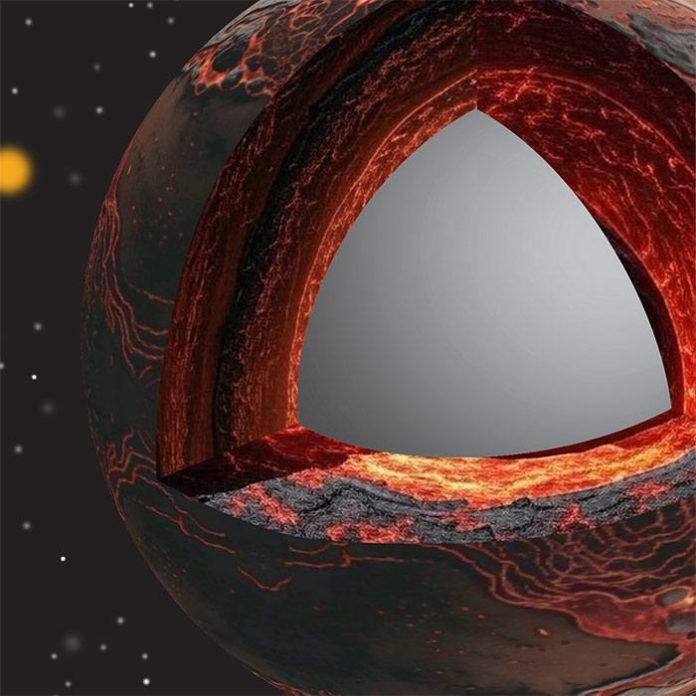
Two massive, mysterious structures deep within Earth’s mantle, the LLSVPs and ULVZs, are revealed as ancient fingerprints of core material mixing into the early magma ocean, a process vital to the Earth’s unique habitability
For decades, two enormous, enigmatic structures buried nearly 1,800 miles beneath Earth’s surface, at the boundary between the mantle and the core, have baffled scientists.
These anomalies, known as Large Low-Shear-Velocity Provinces (LLSVPs) and Ultra-Low-Velocity Zones (ULVZs), are so vast and unusual that they defy standard models of planetary evolution. However, a new study, co-authored by Rutgers geodynamicist Yoshinori Miyazaki, proposes a striking explanation: these structures are ancient ‘fingerprints’ of the core and mantle mixing in Earth’s infancy, holding vital clues to why our planet became uniquely habitable.
The findings, published in Nature Geoscience, suggest that core-mantle interactions billions of years ago prevented the Earth’s mantle from forming distinct chemical layers as it cooled, a process that may have ultimately influenced the planet’s ability to support life.
Enigmatic structures signal deep-Earth secrets
The two primary structures under scrutiny are the continent-sized LLSVPs and the thin, molten patches known as ULVZs. One LLSVP sits beneath Africa and the other under the Pacific Ocean. Both are regions of unusually dense, hot rock that dramatically slow seismic waves, signaling an atypical composition.
“These are not random oddities,” said Miyazaki, an assistant professor at Rutgers. “They are fingerprints of Earth’s earliest history. If we can understand why they exist, we can understand how our planet formed and why it became habitable.”
The conventional understanding of early Earth, which was once covered by a global ocean of magma, predicted that the mantle would cool and separate into distinct, strong chemical layers. Yet, seismic studies reveal irregular piles of the LLSVPs and ULVZs at the planet’s base, contradicting the expected layered structure.
The missing piece of data: Earth’s mantle and core
Miyazaki and his collaborators concluded that the key missing piece of the puzzle is the core itself. Their geodynamic model suggests that over billions of years, elements like silicon and magnesium, which typically reside in the core, leaked into the overlying molten mantle, mixing with it and preventing strong chemical layering from occurring.
The researchers propose that the LLSVPs and ULVZs are, in fact, the solidified remnants of a contaminated “basal magma ocean,” infused with material from the core.
“If we start from the magma ocean and do the calculations, we don’t get what we see in Earth’s mantle today,” Miyazaki explained. “What we proposed was that it might be coming from material leaking out from the core. If you add the core component, it could explain what we see right now.”
Linking deep-Earth chemistry to habitability
The implications of this core-mantle interaction extend far beyond deep-Earth chemistry, potentially linking the planet’s internal evolution to its surface conditions. The core’s influence on the mantle may have dictated the process by which Earth cooled, the nature of its volcanic activity, and the development of its atmosphere.
This mechanism offers a potential explanation for the critical differences between Earth and its planetary neighbors:
- Earth has oceans, life, and a stable atmosphere.
- Venus is a scorching greenhouse with an atmosphere 100 times thicker and mostly carbon dioxide.
- Mars is a frozen desert with a very thin atmosphere.
“What happens inside a planet, that is, how it cools, how its layers evolve, could be a big part of the answer,” Miyazaki stated.
This new view reconceives the LLSVPs and ULVZs as vital clues to Earth’s unique formative processes, suggesting they may even feed modern volcanic hotspots like Hawaii and Iceland, connecting the planet’s deepest interior to its surface. As co-author Jie Deng of Princeton University noted, “The idea that the deep mantle could still carry the chemical memory of early core–mantle interactions opens up new ways to understand Earth’s unique evolution.”










